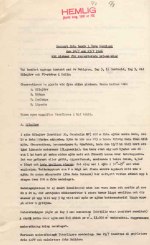Mysterious visitors in northern Scandinavia
"The reports are coming in like drops in a rainstorm"
Norrbottens-Kuriren, 8th of January, 1934.
During the winter of 1933-34 many people in the Norrbotten area, in the northern part of Sweden, witnessed mysterious, silent aircraft performing strange manoeuvres in the night sky. Neither blizzards nor fog appeared to hamper the ghostly aircrafts...
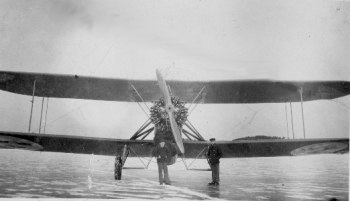 Scouting plane Heinkel HD 16, T 1. Luleå 1934.
Scouting plane Heinkel HD 16, T 1. Luleå 1934.
The Swedish Air Force was finally forced to deploy several reconnaissance airplanes. For three months the planes patrolled northern Sweden, hunting the mysterious ghost fliers. Patrols where also sent out on skis to different mountains, for instance Degerberget, to man the 34-inch searchlights that was mounted on the peaks.
The Finnish army also sent up scouting planes trying to identify the unknown aircrafts. The first report came from Kemi on January the 23th 1934 and described "A shining bright light, just like a blowtorch ". In mid-February one of the Army's aircraft patrolled the route along Kemi-Rovaniemi-Ranua-Simojärvi-Oulu, but with no result.
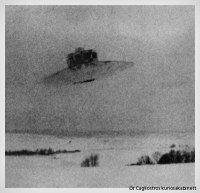
On the 5th of February 1934, an unknown aircraft was reported to have made an emergency landing on the nearly inaccessible Fagerfjell-mountain, about ten miles from the Norwegian town of Trømsø. When rescuers finally arrived however, they only found two sets of gigantic grooves in the snow. The grooves were about 250 feet long, and fourteen feet wide, and appeared to be deep sliding marks or tracks. Several credible witnesses, whom had seen the crash through their binoculars, reported that they had observed two or more people moving around the downed craft .Footprints collaborating this were also found in the snow. Two days later, experienced aviation experts, who had climbed up the mountain to investigate the site of the incident, stated that it was impossible for a plane to take off from the site. Despite this the Norwegian General Staff later announced that the craft had in fact been a German prototype airplane and not a ghost-flyer.
On the second of February 1934, in a parliamentary debate about the ghost-flyers, the Swedish Prime Minister Per Albin Hansson declared that since it was not yet proven that the ghost-flyers actually existed, there was absolutely no reason to take any action. However, only a few days earlier, the military commander of Northern Sweden, General Pontus Reuterswärd claimed the opposite in an interview with the newspaper Norrbotten Kuriren:
"Aircrafts have been observed by credible people, both military and civilian. There for, I am certain that that these flights have been taking place within the restricted area".
Swedish and Norwegian authorities were also exchanging secret information with each other, and a large number of Swedish police reports and newspaper clippings can been found in the Norwegian archives. Among them is a classified Swedish list of 96 unexplained but confirmed sightings of ghost-flyers between September 1933 and 23 February 1934.
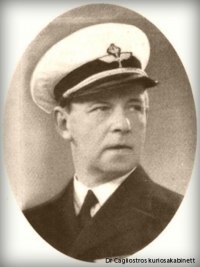 Colonel Gösta von Porat.
Colonel Gösta von Porat.
In 1934 major Gösta von Porat was commissioned by the Swedish Royal Air Force to form a secret committee, to investigate the strange ghost flier phenomenon. The committee was code named Project Searchlight. Many critics have subsequently claimed that the enormous magnitude of the ghost flier phenomenon in northern Sweden could be directly linked to certain objects that von Porat recovered from the Svea mine on Spitsbergen in 1927. These mysterious objects were supposedly stored in the area of Luleå or Boden at the time of ghost flier activities.
In Finland the general staff presented their report on the ghost-flyers at a press conference on January the 4th, 1937. Their conclusion was that most of the ghost-flyer sightings could be explained by weather conditions and inaccurate observations.
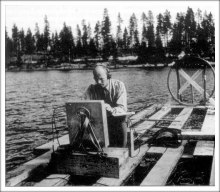 Karl-Gösta Bartoll on Lake Kölmjärv 1946. Photograph used with kind permission of the Swedish Archives for UFO Research.
Karl-Gösta Bartoll on Lake Kölmjärv 1946. Photograph used with kind permission of the Swedish Archives for UFO Research.
Largely as a result of the ghost-flyer phenomenon, however, politicians and military officers agreed on the importance of improved air defences in northern Sweden. In 1939 construction began on the country's northernmost air force base - the F21 in Luleå. It's first commander was to be Colonel Gösta von Porat, who had been involved in the hunt for the ghost fliers for more than a decade.
On the 19th of July 1946, an unknown craft crashes into lake Kölmjärv. Air Force officer Karl-Gösta Bartoll is in charge of Project Searchlight's three week salvage of the craft. A civilian survey later discovered that "the bottom of the lake had been disturbed by a large object". The Air Force and Bartoll were finally forced to admit that something had indeed crashed into lake Kölmjärvi, but that the object probably had disintegrated.
The Swedish Air Force appoints a special Space Projectile Committee, also called The Ghost Rocket Committee to investigate the phenomenon. The chairman was Colonel Bengt Jacobsson, head of the Swedish Air force Materiel Administration.
Officially, the Committee claims that the ghost rockets are experimental Russian missiles, but on the 21th of November, 1946 the committee gathers for the last time without presenting any explanation of the phenomenon.
The events in Sweden aroused such an enormous amount of attention that two U.S. experts on aerial warfare - aviation legend General Jimmy Doolittle and General David Sarnoff, president of RCA, travel to Stockholm independently of each other, both allegedly on unrelated personal business. However, The New York Times can confirm that the two generals on numerous occasions were briefed by the Swedish National Defence Headquarters concerning the ghost-flyer phenomenon, and that they were also given access to several highly classified reports.
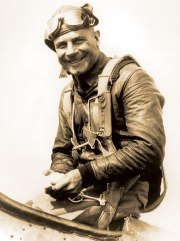 General Jim Doolittle
General Jim Doolittle
Anonymous sources also claim that the two generals were presented with top secret material during a meeting with Colonel von Porat at The Boden Fortress in August 1946.
In 2010, the Swedish Armed Forces attempted once and for all to squash the idea of the existence of alien spacecraft in Swedish airspace, by publishing secret FOI (The Swedish Defence research agency) files concerning the ghost-flyers and other unidentified flying object. However, the published part of the material contains mostly reports of the public's observations, and extracts from public records - all non-classified material with little or no interest to researchers in the area.
What Project Searchlight really know out about the ghost-flyers, and what Colonel von Porat hid deep in The Boden Fortress will, for now at least, remain a mystery...
O. H. Hejll, Curator.




